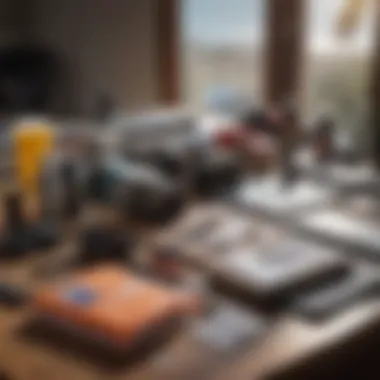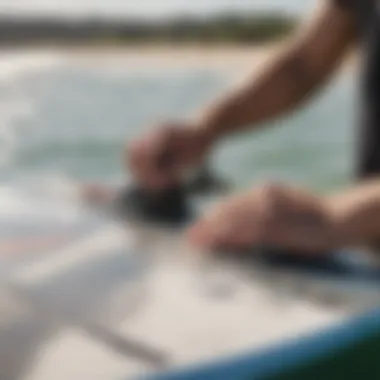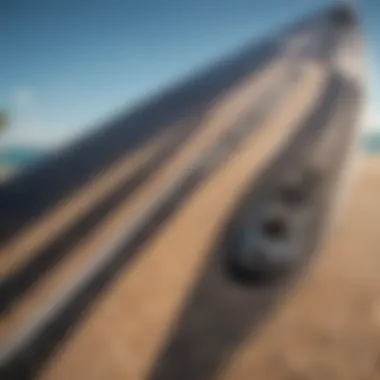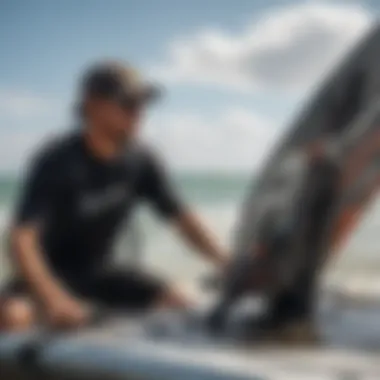Essential Kiteboard Repair Kits: A Complete Guide


Intro
Kiteboarding is an engaging sport that combines the elements of surfing and flying. Yet, it can come with its own set of challenges, especially when it comes to equipment maintenance. Understanding kiteboard repair kits is crucial for ensuring that equipment remains functional and safe. This guide focuses on the various components found in these kits, effective repair methods, and how to maintain your gear properly.
Having a solid repair kit allows kiteboarders to address issues that may arise on the water, from minor damage to equipment failures. This preparedness can enhance the kiteboarding experience by minimizing downtime. We will explore several aspects of kiteboard repair kits, providing a comprehensive insight into their significance and usage.
Equipment Reviews
Kites
Kites vary widely in design and functionality. When considering a new kite, pay attention to model features, sizes, and materials. Specific brands like Naish and Cabrinha have models suited to different skill levels and conditions. Kites can be categorized based on shape, such as delta or bow kites, and each offers unique performance characteristics. For instance, delta kites often provide better low-end power, while bow kites are known for their versatility.
Choosing the right kite depends not just on your skill level, but also on your preferred riding style. It's recommended to read reviews on various sites like reddit.com, as they provide firsthand experiences and insights about specific models.
Boards
Boards are crucial as they dictate a rider's performance on the water. You may explore options between twintip boards and directional boards. Twintip boards, favored by freestyle riders, are typically symmetrical and handle easily in a variety of conditions. Directional boards, on the other hand, are designed for wave riding and are shaped to perform best in those conditions.
Materials are significant too. Boards made from carbon fiber are lightweight and durable, while those made from fiberglass offer more flex and comfort. Brands like North and Slingshot provide various options suitable for different riding styles, ensuring that there is a board that fits your needs.
Accessories
Kiteboarding accessories are vital to having a safe and enjoyable experience. Essential accessories include harnesses, lines, pumps, and safety gear.
- Harnesses: Awell-fitted harness distributes pull effectively.
- Lines: Make sure to use quality lines as they are fundamental for control.
- Pumps: An efficient pump saves time when setting up.
- Safety Gear: Helmets and impact vests can significantly reduce injury risk.
Assessing the importance of each accessory helps in making informed purchasing decisions. Always consult resources like facebook.com for communities discussing recent trends and innovations in kiteboarding gear.
Prelude to Kiteboard Repair Kits
Kiteboarding is an exhilarating sport that demands not only skill but also a keen sense of maintenance. Understanding the fundamentals of kiteboard repair kits is crucial for anyone serious about the sport. These kits are not just spare parts; they are essential tools that help ensure the longevity and performance of your kiteboard.
Importance of Kiteboard Maintenance
Proper maintenance of your kiteboard significantly impacts its performance and safety. Kiteboards endure harsh conditions, including strong winds and choppy waters. Over time, materials can wear down, leading to issues such as minor leaks or structural damage. These problems, if left unattended, may escalate, resulting in costly repairs or a complete replacement of your board.
Maintaining your kiteboard through periodic inspection and timely repairs enhances your riding experience. Regular check-ups can identify potential issues before they become serious, providing peace of mind while you ride. Moreover, investing in maintenance can improve the effectiveness and responsiveness of your equipment, allowing for a better performance during every session on the water.
When to Use a Repair Kit
The ability to recognize when to use a repair kit is vital for kiteboarders. Immediate action should be taken if you notice any signs of damage. Common indicators include the presence of abrasions, punctures, or delaminated sections. Using a repair kit can save you time and money, helping you avoid a trip to a professional.
Here are some scenarios that warrant the use of a kiteboard repair kit:
- Small leaks: If water entry is detected, even in small amounts, it is time to act.
- Visible damage: Any signs of tearing or significant scrapes should prompt a review of the repair options available.
- Delaminated area: Changes in the board's surface indicate that glued areas are separating, which is a crucial issue to address.
By using a repair kit at the first sign of trouble, you can extend the life of your kiteboard and keep your ride safe and enjoyable. Regular attention to the equipment not only enhances your overall kiteboarding experience but also reinforces the importance of being proactive in your maintenance efforts.
Components of a Kiteboard Repair Kit
Kiteboarding demands a unique set of equipment that can withstand the forces of nature. With that, a kiteboard repair kit becomes a critical asset for anyone looking to prolong the lifespan of their gear. Understanding the components of an effective repair kit ensures kiteboarders can address issues promptly and efficiently. Proper knowledge of these components not only saves time but also money in repair costs.
Patch Materials
Having the right patch materials is essential in any kiteboard repair kit. These materials come in various forms, including fabric patches, vinyl, and specialized repair tape. The choice of patch material can significantly affect the quality of the repair.
- Fabric Patches: Often made from durable nylon or polyester, these patches are ideal for covering larger tears or holes. Look for patches that are UV-resistant to ensure longevity against sun exposure.
- Vinyl Sheets: These are useful for quick patches on areas that may sustain abrasion. They can conform to various shapes, making them versatile for different repair needs.
- Repair Tape: This is typically a waterproof adhesive tape designed for temporary fixes. It should have strong adhesive properties to hold up against water and air pressure.
Using high-quality patch materials contributes greatly to the durability of the repair and ensures that the board can take on the challenges of the water. The effectiveness of repairs often hinges on the choice of patch materials.
Adhesives and Sealants


While patch materials are crucial, the right adhesives and sealants designed for kiteboard repairs are just as important. They aid in creating a sturdy bond between the patch and the board material. The adhesives should be effective under various conditions and should resist degradation from water and salt.
- Epoxy Resins: These are excellent for permanent repairs due to their strong bonding capabilities. Epoxies work well with many materials, making them ideal for more complex repairs.
- Super Glue: Useful for quick fixes on minor cuts or cracks, super glue is not recommended for high-stress areas but can be handy in a pinch.
- Marine Sealants: These sealants fill gaps and crevices, providing a waterproof seal. They are ideal for preventing water seepage through repaired areas.
Choosing the right adhesive or sealant will directly impact the longevity and effectiveness of the repair. It is advisable to always check for specific compatibility with the materials of your kiteboard.
Tools Required for Repairs
Effective kiteboard repairs require specific tools to ensure that the application of both patches and adhesives is precise and thorough. A well-rounded repair kit will include basic hand tools that aid in the repair process.
- Scissors or Utility Knife: Essential for cutting patches to size and trimming excess material.
- Screwdrivers: Depending on your board's components, having a set of screwdrivers handy can be beneficial, especially for replacing hardware or adjusting bindings.
- Scraper: Useful for removing old adhesive or any debris from the board's surface to prepare for a new patch application.
- Clamps: These can help hold patches in place while adhesives cure, ensuring a secure fit.
A comprehensive toolkit ensures you are equipped to handle a variety of repair situations effectively. In addition, having all the necessary tools organized in one location can make the repair process smoother and faster. Remember, the key to maintenance is preparedness.
Basic Types of Repairs
Understanding the various methods of repairing a kiteboard is fundamental to maintaining its performance and extending its lifespan. The kiteboard often endures significant strain during use, which can lead to various types of damage. Being equipped with knowledge on basic repairs enables kiteboarders to respond quickly to issues, ensuring that their equipment remains functional and safe to use.
Repairing Small Leaks
Small leaks are among the most common problems kiteboarders face. These leaks can occur due to wear and tear or minor impacts. Addressing them promptly is crucial, as even a small leak can lead to water accumulation inside the board. To repair small leaks, one should first dry the area thoroughly.
- Identify the source of the leak. Look for air bubbles when submerging the board in water during your inspection.
- Clean the area. Remove any debris or oil to ensure adhesive adherence.
- Apply a patch. Use a patch material from your repair kit along with a suitable adhesive. Make sure to spread the adhesive smoothly for a secure bond.
- Let it cure. Follow the instructions regarding curing time before using the board again.
Using this straightforward technique, kiteboarders can save themselves the inconvenience and expense of professional repairs.
Fixing Delaminated Sections
Delamination occurs when layers of the board separate due to poor construction or excessive force. This can significantly affect the board's integrity and performance. To fix delaminated sections, follow these steps:
- Assess the damage. Determine how extensive the delamination is. Minor delamination may be easier to manage than significant areas.
- Open the delaminated area. Gently pry apart the sections to allow for proper cleaning and adhesive placement. Be cautious not to damage surrounding areas.
- Use an appropriate adhesive. Devote adequate attention to ensure even application, using a syringe for precise control can be helpful.
- Clamp the board securely. Use clamps or weights to hold the parts together while the adhesive cures. This is important for a strong bond once repaired.
Timely intervention on delaminated sections can restore the board's performance, preventing further complications.
Replacing Ripped Fabrics
Ripped fabrics on a kiteboard not only compromise aesthetics but also performance. Rips can result from fraying, snagging, or impacts. To replace ripped fabrics:
- Cut away frayed edges. Carefully trim any loose or frayed fabric, ensuring the area is clean.
- Select a patch material that matches the board. The material should be durable and compatible with the board’s fabric to maintain its integrity.
- Adhere the patch. Use an adhesive designed for fabric repairs. Ensure that the patch is well-sized to provide adequate coverage over the rip.
- Sew for reinforcement if necessary. In some cases, sewing the patch can bolster the repair, particularly in high-stress areas.
By effectively replacing ripped fabrics, kiteboarders not only ensure their equipment remains reliable but also maintain the safety required for extreme sports activities.
Advanced Repair Techniques
Advanced repair techniques for kiteboards are crucial for maintaining the integrity and performance of your equipment. While basic repairs often address minor issues, more extensive damage requires a deeper understanding and specific methods to ensure reliability. Employing advanced techniques can not only prolong the lifespan of your kiteboard but also enhance its functionality. This section highlights two key methods: reinforcing weak areas and restoring the board shape.
Reinforcing Weak Areas
Reinforcing weak areas of the kiteboard is essential for preventing further damage and ensuring stability during rides. These weak points often arise from wear and tear, impacting the board's performance. When reinforcing, you typically use patch materials and strong adhesives designed specifically for the kiteboarding environment. The following steps should guide you:
- Identify Weak Points: Start by inspecting the board for cracks, soft spots, or any signs of delamination. Pay close attention to areas around the fins and rail edges.
- Prepare the Surface: Clean the identified area thoroughly. Removal of old adhesive, dirt, and moisture is vital for achieving a strong bond.
- Apply Patch: Cut a patch from suitable material, such as fiberglass or carbon fiber. Size it appropriately to cover the damaged area, ensuring a little overlap onto the solid surface. Place the patch over the weak area.
- Use Proper Adhesives: A high-quality epoxy or polyurethane adhesive works well for this application. Apply evenly and follow the manufacturer's instructions.
- Cure Time: Allow sufficient curing time according to product guidelines. Skipping or rushing this step can compromise the repair.
By following these steps, you ensure that the board maintains its structural integrity and enhances performance while in use. This repair may seem complex, but with patience and attention to detail, it is very achievable.
Restoring Board Shape
Restoring your kiteboard's original shape is vital for maintaining its aerodynamic properties and overall performance on the water. A deformed or warped board can negatively affect your riding experience and can lead to severe equipment failure. Here, the process of restoration encompasses several crucial steps:
- Assess Damage: Identify areas where the shape has been compromised. This could be due to impact, pressure dings, or prolonged exposure to heat.
- Sanding: If the board is warped, sanding may be necessary. You should carefully sand the affected areas to reshape them. Remember to wear a mask to avoid inhaling dust.
- Use of Heat: In some cases, applying gentle heat can help restore the board shape. Use a heat gun or a warm towel, but be cautious. Excessive heat can cause further damage, so this should be done judiciously.
- Resin Application: After achieving the desired shape, apply a fresh layer of resin to hold the new form. This helps solidify the repair and creates a waterproof barrier.
- Curing Process: Just like reinforcing, curing the resin is critical. Ensure it sets properly to achieve the intended durability and performance.
Preventive Maintenance Tips


Preventive maintenance is key for kiteboard longevity and optimal performance. Ignoring maintenance can lead to costly repairs or even accidents while riding. This section highlights essential practices to keep your kiteboarding equipment in the best possible condition.
Regular Inspections
Regular inspections are crucial for identifying potential issues before they escalate. Before each session, take a few minutes to check your kiteboard for any visible signs of wear or damage. Look for cracks in the board, peeling paint, or any signs of delamination. You should also inspect the foot straps and pads for any rips or tears.
Create a checklist for your inspections:
- Check the board surface for scratches or cracks.
- Inspect foot straps for snugness and integrity.
- Ensure fins are secure and free of damage.
- Look at all seams for any signs of wear.
By consistently inspecting your gear, you can catch small issues early, help prevent malfunction during use, and enhance safety while riding.
Storage Practices
Proper storage practices can significantly extend the life of your kiteboard. After use, clean your board with fresh water to remove salt or sand. Avoid leaving your equipment in direct sunlight for prolonged periods. Ultraviolet rays can degrade materials and reduce performance.
When storing your kiteboard, follow these guidelines:
- Use a protective cover to shield from dust and UV light.
- Store in a cool, dry place, away from extremes in temperature.
- Keep boards vertically or on end to avoid warping.
Taking care of storage will prevent unnecessary wear and tear, ensuring that every kiteboarding session is a great experience.
Remember: Regular maintenance and attentive care are essential for maximizing the lifespan of your kiteboard and enhancing your overall kiteboarding experience.
Choosing the Right Repair Kit
Selecting the appropriate repair kit is crucial for maintaining the longevity of your kiteboard. A well-chosen kit can make the difference between a successful repair and a frustrating experience during your next kitesurfing session. Not all kits are created equal; therefore, understanding the essential elements and benefits can guide kiteboarders toward making informed decisions. The right repair kit should contain necessary components and be suited for your specific needs.
Essential Features to Look For
When evaluating repair kits, several features stand out that can significantly enhance your repair experience:
- Patch Material Quality: High-quality materials can make repairs more durable. Look for kits that offer UV-resistant and water-resistant fabrics.
- Versatile Adhesives: A good kiteboard repair kit should come with strong adhesives that can bond well with various materials like PVC, XPS foam, and different fabrics. Ensure the adhesive is suitable for both air and water exposure.
- Comprehensive Toolset: Having the right tools is vital. A repair kit should ideally include a knife for trimming patches, a scissors, and possibly scrapers for prepping the surface.
- Clear Instructions: A kit that comes with detailed instructions can be helpful, especially for those less experienced with repairs. Look for visual guides or step-by-step manuals that simplify the process.
- Portability: The ideal repair kit should be lightweight and compact, allowing you to easily carry it during kiteboarding sessions.
Brands and Quality Assessment
When selecting a repair kit, consider reputable brands known for their quality products. Some brands like Dakine, SIC, and Cabrinha have established a strong reputation in the kiteboarding community. Assessing brand quality involves looking at user reviews, warranty offers, and material specifications provided by the manufacturer.
It's important to remember that a well-regarded brand does not just signify quality but also implies that the kit is designed specifically for kiteboard repairs. Researching common issues faced by kiteboarders can also provide insight into which kits stand up well under various conditions.
Given the nature of kiteboarding, where equipment undergoes significant stress, investing in a high-quality repair kit can save time and resources in the long run. A cheap kit may offer short-term solutions but can lead to more extensive repairs later due to inadequate materials or tools.
"Choosing the right repair kit is not merely about fixing your kiteboard; it is an investment in your overall kitesurfing experience."
DIY vs Professional Repairs
When dealing with kiteboard repairs, the decision between DIY repairs and seeking professional help is paramount. Each approach has its distinct advantages and challenges. Understanding when to choose one over the other can significantly impact the longevity and performance of your equipment.
When to Attempt DIY Repairs
DIY repairs can be a good option for many kiteboarding enthusiasts, particularly for minor damages. If the issue involves small leaks or superficial fabric rips, you may find that a DIY approach suffices. Benefits of attempting repairs on your own include:
- Cost Efficiency: DIY repairs can be less expensive than hiring a professional. Basic repair kits are often affordable and can provide the necessary tools and materials.
- Learning Opportunity: By undertaking repairs on your own, you can gain valuable experience and a deeper understanding of your equipment.
- Timeliness: Depending on the situation, addressing simple repairs yourself can save time and allow you to get back on the water sooner.
However, approaching DIY repairs requires honesty about your skills and the damage extent. For example, if you encounter more complex issues, like severe delamination or structural damage, it may be wiser to consult an expert.
Recognizing When to Seek Expert Help
There are specific circumstances when professional support becomes essential for kiteboard repair. Engaging experts ensures that repairs are done correctly and safely. Key factors that indicate the need for professional help include:
- Complex Repairs: If the damage is extensive, such as deep tears, structural issues, or potential impacts on board performance, a professional will have the necessary expertise and equipment.
- Safety Concerns: Equipment performance is critical to ensuring rider safety. If you are unsure about the integrity of your kiteboard after a mishap, consulting an expert is wise to prevent accidents.
- Time Constraints: While some repairs are manageable at home, if time is of the essence, a professional can often expedite the repair process, allowing you to return to kiteboarding without prolonged interruptions.


In summary, both DIY and professional repairs have their place in kiteboard maintenance. Assessing the damage, your capabilities, and the urgency of the repair can help guide your decision. \n> "Understanding your equipment allows for better care. Sometimes that means reaching out for help."
Ultimately, being proactive with repairs, whether you choose the DIY path or enlist professional help, can enhance your kiteboarding experience and extend the lifespan of your gear.
Cost Considerations for Repairs
When it comes to kiteboarding, the importance of understanding repair costs cannot be overstated. This section aims to provide insight into the financial aspects of kiteboard maintenance and repair. Being aware of expenses can help kiteboarders make informed decisions, ensuring their equipment remains in optimal condition without breaking the bank.
Budgeting for Repairs
Creating a budget for kiteboard repairs involves several considerations. First, assess your usage frequency. Frequent riders may encounter more wear and tear, necessitating a larger budget for maintenance. In contrast, those who kite less might allocate funds differently. Here are some factors to include:
- Initial Kit Cost: The upfront investment in a quality kiteboard repair kit will typically range from $20 to $100. Familiarize yourself with your options early on to avoid overspending later.
- Repair Types: Different repairs come with different costs. Small fixes like patching a leak usually require minimal resources, while extensive restarts or fabric replacements demand a greater financial commitment.
- Frequency of Damage: If you regularly find your equipment in need of repairs, it might be worth considering more durable options that could reduce long-term costs.
Set aside a portion of your budget specifically for emergencies. This cash reserve can ease stress when an unexpected issue arises, ensuring you are quickly back on the water.
Long-term Value of Maintenance
The long-term benefits of maintaining your kiteboard can be substantial. Regular maintenance often leads to significant savings over time. Like any other equipment, handling minor repairs promptly prevents small issues from escalating into costly repairs later.
Consider these aspects:
- Enhanced Longevity: Well-maintained boards typically last longer. This means you can delay purchasing a new board, ultimately saving money.
- Performance Optimization: Equipment in good condition performs better, leading to a better riding experience. If you avoid major repairs, you enjoy more time on the water.
- Cost-Effective Solutions: Understanding how to fix common kiteboard problems yourself will save labor costs associated with professional repairs. DIY solutions often require minimal materials and tools, thus reducing overall expenses.
Regular maintenance is not just an expense; it's an investment in your riding future.
In summary, comprehending the costs associated with repairs is essential for kiteboarders. By budgeting wisely and recognizing the long-term value of maintenance, you can ensure that your kiteboarding adventures remain enjoyable and sustainable.
Case Studies of Common Repairs
Understanding repair processes through real-life examples offers deep insights for kiteboard enthusiasts. This section contains valuable lessons learnt from specific repairs that kiteboarders have encountered. These case studies highlight common issues, solutions, and the effectiveness of different repair methods. Moreover, examining these cases can lead to better decision-making when dealing with similar situations, enhancing both safety and performance on the water.
Anecdotes from Experienced Kiteboarders
Many kiteboarders have valuable stories to share about their repair experiences. For instance, one experienced kiteboarder encountered a rip in his board after a hard landing. Instead of rushing to a professional repair service, he decided to use a DIY kit. He patched the area with a sturdy adhesive and a quality fabric patch. Not only did he save money, but he also learned a great deal about the structural needs of his kiteboard.
Another kiteboarder faced a common issue with delamination, where the layers of the board began to separate. By observing others and conducting his own research, he learned to reinforce the separated layers with epoxy. This experience not only resolved his issue but also provided him with the confidence to handle future repairs.
These anecdotes illustrate how personal engagement in repairs can lead to empowerment through knowledge. By addressing repair issues directly, kiteboarders familiarize themselves with their equipment and gain a sense of ownership over its maintenance.
Learning from Mishaps
Mistakes are often an excellent source of learning. One particular incident involved a kiteboarder who neglected to check for small leaks after a day of riding in challenging conditions. When he finally discovered the leaks, they had affected buoyancy and maneuverability significantly. This experience reinforced the importance of regular checks before and after each session.
Additionally, another kiteboarder learned the hard way about using incorrect materials for repairs. In an attempt to save time, he used an inferior adhesive that resulted in a messy and ineffective fix. This led to further damage and ultimately required a complete board replacement.
These examples illustrate critical lessons in the importance of routine maintenance and using appropriate tools for repairs. Chalked up to experience, such mistakes can be transformative, leading to a more cautious and knowledgeable approach in future repairs.
"Learning from both successes and failures shapes one's approach to kiteboarding and emphasizes the importance of being proactive in repairs."
Both stories remind kiteboarders—whether beginners or seasoned professionals—of the significance of sharing experiences. Learning from others’ mistakes can dramatically enhance one’s understanding of the tools and methods available, ensuring that they are better equipped to tackle their own repairs.
Ending
The conclusion of this guide to kiteboard repair kits serves a crucial purpose. It encapsulates key insights while reiterating the importance of maintaining kiteboarding equipment. Proper upkeep not only enhances performance but also prolongs the lifespan of the gear, allowing users to maximize their investment. The discussion of repair kits informs both novice and experienced kiteboarders about essential resources required for effective repairs.
Recap of Key Points
This article discussed essential aspects of kiteboard repair kits. Key points include:
- Importance of Maintenance: Regular care is vital for optimal performance.
- Components of Repair Kits: Understanding patch materials, adhesives, and necessary tools ensures effective repairs.
- Types of Repairs: Identifying and applying appropriate techniques for various damages helps address issues timely.
- Advanced Techniques: Knowing how to reinforce and restore boards can prevent future problems.
- Preventive Maintenance: Establishing regular inspection and proper storage practices is significant for longevity.
- DIY vs Professional Repairs: Evaluating when to attempt repairs yourself versus when to seek expert help is essential for maintaining equipment integrity.
- Cost Considerations: Budgeting for repairs and understanding long-term maintenance value is crucial for kiteboarding enthusiasts.
- Case Studies: Learning from experiences of other kiteboarders adds practical knowledge.
Future Trends in Equipment Care
The landscape of equipment care is evolving. New technologies and materials are being developed constantly to improve durability and repairability. Advancements like self-healing materials and more effective adhesives are promising. Furthermore, increased accessibility to instructional resources on DIY repairs enhances the capability of kiteboarders to maintain their equipment.
In addition, as the kiteboarding community grows, shared knowledge through platforms like Reddit and Facebook fosters a collaborative atmosphere, leading to further innovation in repair techniques. Staying updated on trends will empower riders to enhance their gear maintenance strategy and overall kitesurfing experience.







